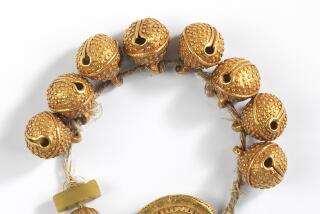TV REVIEW : ‘Frontline’ Explores Black Market in Antiquities
- Share via
“Plunder!,” airing on “Frontline” tonight (9 p.m., Channels 28 and 15; 10 p.m., Channel 50), poses one of the art world’s stickiest questions: Who owns a nation’s cultural heritage? The nation that produced it and may have abused it, or foreigners who take the treasure out of context and reap great profits from it but sometimes take better care of the art than the country of origin?
“Frontline” argues in favor of the country of origin but presents an evenhanded view of the problem. Investigating the international black market in antiquities, “Plunder!” focuses on smuggling from graves of the Lords of Sipan in Peru. The story involves Southern California dealers and collectors who were subjects of a massive U.S. Customs raid in 1988. One dealer, David Swetnam, a young adventurer who operated a gallery in Santa Barbara, recently completed a six-month sentence at the federal prison camp in Boron.
Filmed before his incarceration, Swetnam argues that Peru was so lax in enforcing its export laws that he didn’t take them seriously. New York dealer Andre Emmerichtakes this position further, contending that the United States is not obligated to enforce the export restrictions of other countries. In the case of Sipan, that contention no longer holds up. President Bush on Monday announced that, effective May 7, pre-Columbian artifacts from Sipan will be barred from entry into the United States.
The Sipan tale of high drama involves one death and national outrage, but it reaches its high point in interviews: “The one who loves the baby best gets the baby. The one who will pay the most for the baby gets the baby. If Peru cannot properly take care of its national treasures, the rest of the world will take care of it for the Peruvians, as it should be,” Emmerich says, taking a patriarchal dealer’s point of view.
But he’s no match for Fernando Cabiezas, head of Peru’s National Institute of Culture, who counters, “There’s a mafia . . . selling Peruvian artifacts in the United States and in Europe for profit. . . . There’s a tremendous amount of money going into this. This is prostitution. Like it or not, this is crime.”
Viewers in search of a more complete and colorful version of the Sipan story will find it in an article by “Frontline” reporter Carl Naginin the May issue of Art & Antiques magazine.
More to Read
The biggest entertainment stories
Get our big stories about Hollywood, film, television, music, arts, culture and more right in your inbox as soon as they publish.
You may occasionally receive promotional content from the Los Angeles Times.










